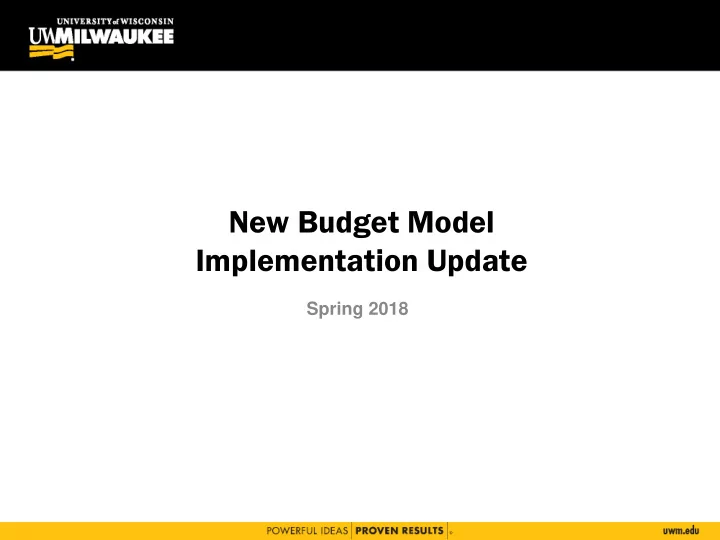

New Budget Model Implementation Update Spring 2018
New Budget Model Rationale • New budget model development began in 2012 • The historic budget model (spaghetti + marginal tuition) was the result of many independent decisions made in a different financial environment • Why change? ▪ To provide continuing transparency around budgets, beyond SPC (Strategic Position Control) ▪ To better fund UWM’s mission and strategic priorities, defined by the campus and informed by metrics ▪ (In light of our new fiscal reality) ▪ To create a more sustainable future for UWM
New Budget Model Rationale • What the budget model is not: • Not going to create new $$ right away • Not going to result in dramatic changes overnight (positive or negative) • Not going to result in mass program closures or layoffs • Not setting departmental budgeting within school/college • This about long-term sustainability and more thoughtful budgeting over the long-term
New Budget Model Five Key Steps 1. #1 #2 #3 #4 #5 Calculate Establish Develop “unadjusted” Establish central Determine “adjusted” budgets for support services strategic preliminary, high- budgets for schools/colleges budgets initiatives funding level budgets schools/colleges (formula)
New Budget Model Step 1 Step 1 : Develop “High Level” Budgets • Campus leadership, in consultation with the APBC: ▪ Considers best projections for overall campus operating revenues (tuition, state appropriations, and indirects from research); and ▪ Proposes preliminary, aggregate budgets for: ▪ Schools/Colleges ▪ Central Support Services & Infrastructure ▪ Including Unit-Wide ▪ Strategic Initiatives
New Budget Model Step 2 Step 2: Using the pool allocated to School/Colleges in Step 1, calculate Unadjusted budgets • Based on a “formula” derived from: ▪ Undergraduate tuition revenue ▪ Graduate tuition revenue ▪ Fund 150 (federal indirect) revenue [More detail on each of these is provided on the next slides.]
New Budget Model Step 2 Step 2, continued: • Undergraduate tuition revenue is pooled and allocated based on 3 factors (all using 2 year averages): 1. Credits conveyed – 70% 2. Research & public service metrics – 20% 3. Undergraduate degrees granted – 10%
New Budget Model Step 2 Step 2, continued.: ▪ Graduate tuition revenue is allocated based on the School/College of enrollment ▪ Increases/decreases in fund 150 (Federal Indirect) revenue are allocated 80% to the generating school/college ▪ Currently 30%
New Budget Model Step 2 Step 2, continued: Sample Unadjusted Results New Budget Model - Formula Results (100%)- New Budget Model- Current Budget Model Unadjusted Allocations Adjustments A B B-A (B-A)/A C B+C Difference in Difference, as Step #2 Base, between a % of Adjusted Unadjusted New and Current Current Step #3: Budget College/School (EXAMPLES) 2016/17 Revenue 2016/17 Base Model Model Base Adjustments (2016/17) 51 - Information Studies 5,671,636 6,212,910 541,274 9.5% 65 - Nursing 11,558,273 9,080,561 (2,477,711) -21.4%
New Budget Model Step 3 Step 3: Establish Adjusted Budgets for Schools & Colleges, based on additional factors: ▪ Missions and expected costs of instruction and research ▪ Six-year financial forecasts , including school/college enrollment projections ▪ Academic and research effectiveness , with benchmarking as available ▪ Campus strategic opportunities or priorities ▪ Historical revenue and expense levels , including campus investment decisions
New Budget Model Step 4 Step 4: Establish Central Support Services and Infrastructure budgets, based on: ▪ Six-year forecasts of total expenses and revenues ▪ Historical revenue and expense levels including campus investment decisions ▪ Opportunities for efficiencies such as through reorganization, consolidation or implementation of technology ▪ Peer benchmarks around efficiency and effectiveness ▪ Campus strategic opportunities or priorities , including contribution of foundational support to the university ▪ Changes in other factors that may impact the relative needs for services
New Budget Model Step 5 Step 5: Allocate Strategic Initiatives Fund Budget: ▪ The Chancellor will articulate strategic priorities for the campus outside of any budget-building process. ▪ Proposals will be solicited from the leaders of campus groups who are responsible for carrying out the campus strategic opportunities/priorities, and/or Deans/Division Heads, as determined by the Chancellor. ▪ Proposals will be reviewed by a “Strategic Investment Team” appointed by Chancellor ▪ Based on these strategic priorities, initiatives may be selected for seed funding or investment.
New Budget Model Additional Information Role of the Academic Planning & Budget Committee: ▪ The APBC is the governance body to provide input and advice in the budget building process, when: ▪ Establishing high-level budgets for four units (Step 1) ▪ Establishing adjusted budgets for schools/colleges (Step 3) ▪ Establishing central infrastructure budgets (Step 4) ▪ Considering reallocation of carryforward balances ▪ The APBC has been undertaking a rigorous financial curriculum this year to assume this role
New Budget Model Additional Information New budget model process will first be implemented for the FY 2020 budget year Step Who? Timing Step 1: Develop high-level Campus leadership in August 2018 budgets consultation with APBC Step 2: Calculate unadjusted Office of Budget & Planning September 2018 budget for each School/College Step 3: Establish adjusted Provost-led in consultation October/November 2018 budgets for Schools/Colleges with APBC Step 4: Establish Central Provost/VC-led in October/November 2018 Support Services Budgets consultation with APBC Step 5: Allocate Strategic Chancellor/Designee September-December 2018 Initiatives Fund budget Build budget decisions into All divisions February/March 2019 budget system
Additional Information Graduate Assistant Remissions Questions?
Recommend
More recommend